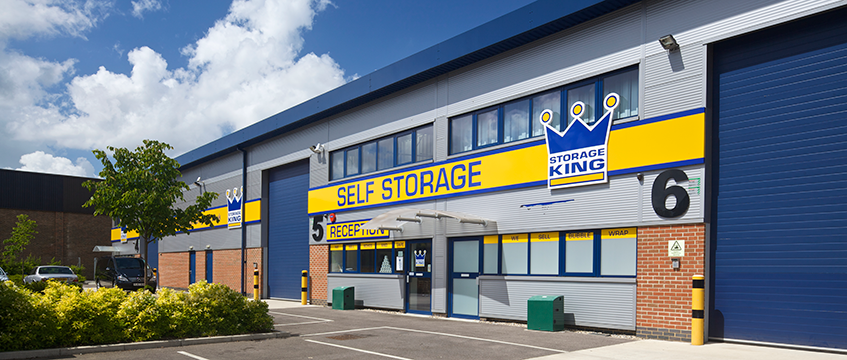Storage King’s new owners seek UK expansion
South African REIT Stor-Age’s £77m acquisition of UK platform Storage King is the latest new entrant looking to quickly amass scale in the UK self-storage market.
Last month Schroders’ UK Real Estate Fund entered the sector by acquiring The Self Storage Company for £44m, while US operator Storage Mart bought Big Box in a £100m deal in October last year.
Stor-Age’s acquisition similarly gives the South African investor instant access to the UK’s sixth-largest self-storage business. The deal includes Storage King’s 25-strong UK portfolio, which is based in the South and the South East, an area particularly lucrative in the self-storage market owing to the more expensive housing market.
South African REIT Stor-Age’s £77m acquisition of UK platform Storage King is the latest new entrant looking to quickly amass scale in the UK self-storage market.
Last month Schroders’ UK Real Estate Fund entered the sector by acquiring The Self Storage Company for £44m, while US operator Storage Mart bought Big Box in a £100m deal in October last year.
Stor-Age’s acquisition similarly gives the South African investor instant access to the UK’s sixth-largest self-storage business. The deal includes Storage King’s 25-strong UK portfolio, which is based in the South and the South East, an area particularly lucrative in the self-storage market owing to the more expensive housing market.
The Storage King team will continue to run the assets and they will remain branded as Storage King. Robin Greenwood, Storage King’s chief executive, says the deal and subsequent cash injection was the next logical step for its business strategy.
“Stor-Age wants us to retain management and then it will expand the portfolio through acquisitions. We are now actively looking for freehold opportunities. With Cabot [the previous owner] we could focus only on refurbishment, but now we can also look at brownfield sites and there is more of a long-term plan.”
Refurbishing industrial land
Without sufficient backing, expansion can be problematic. Greenwood adds that the biggest opportunity it will be exploring now is the refurbishment of former industrial land, through freehold acquisitions, which can be reconfigured into storage.
However, constraints on land supply, competition from other asset classes and burdensome planning processes, particularly in urban areas all make development difficult.
One of the main advantages of buying into an existing platform, as these investors have done, is that you instantly overcome the barriers to entry caused by development constraints in the sector.
James Gibson, chief executive officer of Big Yellow Group, the UK’s second-biggest self-storage company (see box) says: “Developing new self-storage space, particularly in metropolitan areas, is increasingly difficult because of competition for land and planning constraints. These transactions, therefore, are reflective of the fact that capital seeking self-storage exposure is having to buy existing assets rather than develop new ones.”
These barriers to entry and expansion will remain in place. This means that those that are investing are taking a long-term view.
As an operational asset, economies of scale are also important in the self-storage sector and investors need to have a well-known and reliable brand in order to maintain and increase revenue across their portfolios.
Fixed-cost business
Gibson explains: “Self-storage is a relatively fixed-cost business that benefits greatly from scale. If you can create a bigger business, then you can make the overheads more efficient. It also gives you a higher brand awareness, which is increasingly important with most of our customers coming through our digital platform.
“Our key strategy has been to build this scale, particularly in London and the South East, where we have 65 to 70 stores. We can then benefit from greater efficiency, a stronger brand and the ability to move customers between the stores as we start to reach higher occupancy rates.”
The rise in tech also plays an important role in running a successful self-storage business. Ollie Saunders, lead director, alternatives, JLL, says: “Eighty percent of booking enquiries come from the internet, so the more powerful you are online, the bigger your business is. It is a difficult battle to win if you are a small operator going up against Google and search engine optimization. Then, once your store is nearly full, you can hike the rents. We have seen this significantly in the South East.”
Interest from other sectors has also started to push demand for self-storage assets in certain locations in London. Saunders adds: “You do get gold nuggets of development if you look at the London market. Bondway Self-Storage in Vauxhall is now a tower block, Access Self-Storage in Shepherds Bush is now an office scheme and Safestore in Whitechapel is now resi.”
How have listed self-storage companies performed?
Listed self-storage companies have received a mixed response from the market, with the share prices of the three biggest listed companies – Big Yellow, Safestore and Lok’nStore – rising by 7% from their pre-referendum price.
Most of that growth has come from the AIM-listed Lok’nStore, while Safestore and Big Yellow have stagnated.
Big Yellow has yet to recover from its losses last summer; its share prices hover at about 8% below its pre-referendum level. While Safestore has recovered, it has gone from double-digit recovery to low single digits since June.
The sector sits firmly in the middle of two extremes in market sentiment: London offices, where investors saw share prices tumble by 14.7% from their pre-referendum levels, industrial REITs, whose share prices have increased by 14.1%.
David Brockton, real estate analyst at Liberum Capital, says: “There is some inherent caution from investors with regards to sustainability of demand, principally related to housing volumes and their impact on the storage market. If resi volumes slow, this could weaken demand for self-storage and that has likely curtailed some share price momentum in the sector.
“While the housing market is important, it is not the only driver of demand – it is also driven by life events and business use, among others. We have remained positive on the sector because we feel that the strength of demand is strong and there is a lack of supply, which should in turn continue to drive occupancy and rents.”
To send feedback, e-mail amber.rolt@egi.co.uk or tweet @AmberRoltEG or @estatesgazette











